Landslide
This page provides messages about landslides.
In this section:
- Reduction: Reduce the impacts of landslides
- Readiness: Get prepared to respond to landslides
- Response: What to do if you think a landslide is about to happen
- Recovery: What to do after a landslide
- Landslides occur when sloping ground becomes unstable and rock, soil or vegetation fall down a slope.
- Landslides are commonly classified by the material involved (e.g., rock, debris, soil or mud) and the way they move (e.g., fall, topple, slide, spread, or flow)
- Landslides cause more deaths than any other geological hazard in Aotearoa New Zealand. They can cause significant damage to buildings, roads and other infrastructure. They can also dam rivers and if the dam fails, this can result in flooding downstream.
- The impacts of landslides can be reduced by land use planning, avoiding building on or near unstable land, strengthening the site through engineering solutions and carefully monitoring land for signs of movement.
- Although landslides may be triggered by a number of factors, they are most often triggered by earthquakes and heavy rain.
- If a landslide occurs – or you see any signs that the ground is unstable – evacuate immediately. If lives are in danger dial 111. Otherwise, seek advice from your local council once you are in a safe location.
- Reduce your personal risks – after heavy rainfall, don’t drive unless absolutely necessary and stay away from areas where landslides have occurred previously.
- Seek expert advice from a chartered professional geotechnical engineer if you are planning on excavating or building on steep slopes or believe the site may be affected by landslides.
- Make and practise your emergency plan, have a grab bag and emergency supplies.
- If you learn or suspect that a landslide is occurring or is about to occur in your area: Evacuate immediately, away from the potential slide area if it is safe to do so. Getting out of the path of a landslide or debris flow path is your best protection.
- If you are in a property that could be or is being impacted by landslide debris move to the side of the house furthest from the landslide. This is likely to be the safest location within the property.
- Take your pets with you, and move livestock to safe paddocks, if you can do so without endangering yourself.
- Alert your neighbours. They may not be aware of the potential hazard. Advising them of a threat may save their lives. Help neighbours who need assistance to evacuate if you can do so without putting yourself in danger.
- During a severe storm:
- Stay up-to-date with the latest weather information from MetService, Te Ratonga Tirorangi, New Zealand’s National Weather Service. Pay attention to heavy rain warnings. Short bursts of heavy rain may be particularly dangerous, especially after longer periods of wet weather.
- Be especially alert when driving. Embankments along roadsides are particularly susceptible to landslides. Watch the road for collapsed areas, mud, fallen rocks, and other indications of a possible debris flow.
- Following a landslide, stay away from the landslide area. Further landslides may occur.
A landslide is the movement of rock, soil and/or vegetation, down a slope. There are many different types, and they can range in size from a single boulder in a rock fall, to a very large avalanche of debris with huge quantities of rock and soil that spreads across many kilometres. They are common in both rural and urban settings.
Landslides are commonly classified by the material involved (e.g., rock, debris, soil or mud) and the way they move (e.g., fall, topple, slide, spread, or flow). All these types of landslides may occur in New Zealand. Listed below are some classical examples of different landslide types.
- Rockfall - individual rocks that detach and rapidly fall from steep slopes and cliffs.
- Debris Avalanche - a shallow flow of rock and debris that detach from steep slopes and cliffs fall from steep slopes and cliffs to form an avalanche. The landslides that blocked SH1 after the Kaikoura Earthquake are a classic example of debris avalanches
- Debris Flows - rapid surging flows of saturated debris that occur in channels. They are often triggered by heavy rainfall or rapid snowmelt. A debris flow devastated Matatā on the 18th May 2005.
- Slides - landslides that occur when a zone of weakness separates the slide material from more stable underlying material. They can be rotational or translational. The slow moving Tāhunanui Slump in Nelson is an example of a rotational slide.
Landslides can occur without any trigger but are most commonly associated with heavy rainfall (like the landslides generated during Cyclone Gita in 2018) and earthquakes (like the landslides that impacted SH1 triggered by the 2016 Kaikōura earthquake). Human activities including mining, construction, removal of trees and vegetation, steep roadside cuttings or leaking water pipes can also cause or increase the likelihood of landslides.
Some landslides move rapidly, while others are slow and gradual, causing damage to property and infrastructure, but rarely injuring people. The Taihape Landslide is an example of a slow-moving landslide.
More information on landslide types and processes is available in this USGS fact sheet.
Landslide type diagrams
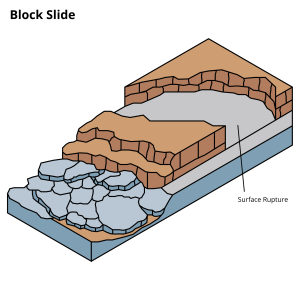
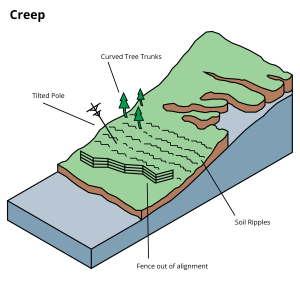
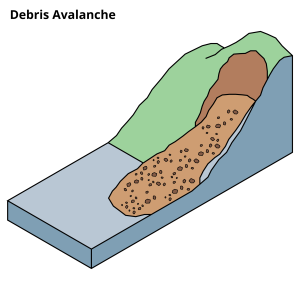
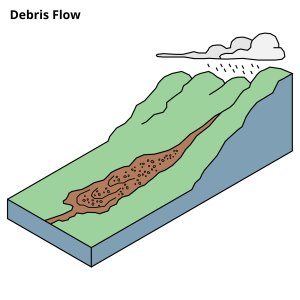
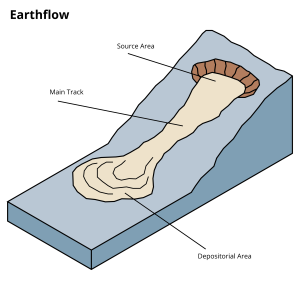
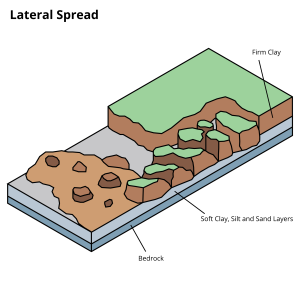
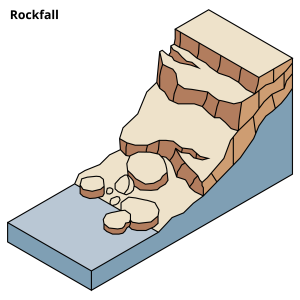
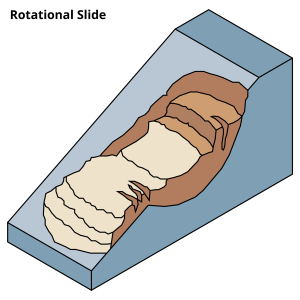
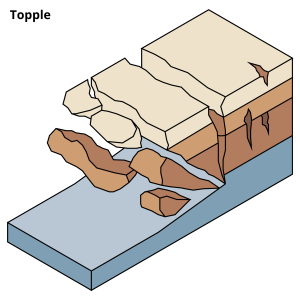

Landslides cause more deaths than any other geological hazard in New Zealand. There have been around 1800 deaths from slips over the past 160 years, more than from earthquakes or tsunami. On average, three people die each year from landslides in New Zealand.
Landslides are also an incredibly destructive force. They damage houses, land and infrastructure – and the clean-up and recovery can be very expensive.
In addition, landslides can create secondary hazards:
- If landslides block streams and rivers, they can dam the water ways. This may lead to the development of lakes upstream of the dam, and these dams can fail rapidly, releasing flood waters down catchments.
- Landslides that fall into water bodies, such as lakes, fiords and the sea can also generate local tsunami waves.
Landslide hazards can be divided into two broad categories: slippage and landslide runout:
- Slippage is the movement or loss of land from a slope when a landslide occurs beneath it (the landslide source area)
- Landslide runout is the inundation of an area by rock, debris, soil and other material that is travelling downslope from the landslide source area. This debris inundation can crush cars, building, people and move heavy objects.
The hazard associated with landslides is determined by the type of landslide that occurs together with its size, travel distance (runout) and speed of movement. Rapid landslides can result in a loss of life and property damage as there is not enough time to evacuate and get out the way. Slow moving landslides may not present a threat to life but can affect many properties and cause significant damage to property and assets. Slow moving landslides can transition into more rapid landslides under certain conditions.
As with any emergency, landslides cause an emotional toll. It can take a long time to restore homes and infrastructure, and in some cases property has had to be abandoned. If you live in an area that’s prone to slips, getting together with your friends, whānau and community and making a plan will help you understand the warning signs, and learn what to do if a landslide event happens.
